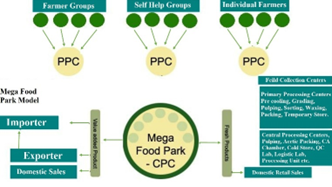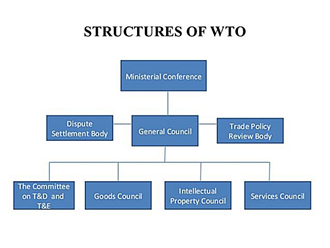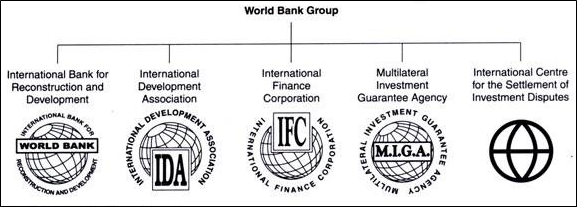In the context of the agriculture sector in India, forward and backward linkages refer to the interconnected relationships between various segments of the agricultural value chain. These linkages are crucial for the development and growth of the agricultural sector and its associated industries.
There are broadly two types of agricultural linkages: Backward and Forward.
A. Backward Linkages
Backward linkages involve the activities and industries that support and supply inputs to the primary agricultural production process.
These activities include:
1. Access to seeds: Seeds make an important part of backward linkages in agriculture. Example – Seed Bank scheme to meet requirement of seeds during natural calamities and unforeseen conditions.
2. Agrochemical Production: Backward linkages include the production and supply of fertilizers, pesticides, and other agrochemicals used in farming. Example – Promotion of Alternate Nutrients for Agriculture Management Yojana (PRANAM) to encourage the balanced use of fertilisers in conjunction with biofertilisers and organic fertilisers. Liquid Nano-Urea Fertiliser – a nutrient to provide nitrogen to plants as an alternative to the conventional urea.
3. Farm Machinery and Equipment: The manufacturing and supply of farm machinery, tractors, and other equipment used in agriculture. Example – Under Sub Mission in Agricultural Mechanization (SMAM) – farmers are provided with the benefit of subsidies ranging from 50 to 80 percent for buying agricultural machinery.
4. Irrigation and Water Management: The development and supply of irrigation systems and water management technologies that enhance agricultural productivity. Example – Pradhan Mantri Krishi Sinchayee Yojana (PMKSY) is launched to provide irrigation facilities and an efficient water management system in the agricultural sector.
5. Research and Development: Agricultural research institutions, universities, and extension services contribute to agricultural innovation and technology transfer. Example – Rashtriya Gokul Mission for development and conservation of indigenous bovine breeds and genetic upgradation of bovine population.
6. Credit and Financial Services: Backward linkages include financial institutions and banks that provide loans and credit to farmers for purchasing inputs and carrying out agricultural activities. Example – Farmers can avail crop loan through Kisan Credit Card, the Pradhan Mantri Fasal Bima Yojana (PMFBY), a crop insurance scheme with very low premiers to be paid by farmers.
B. Forward Linkages
Forward linkages in agriculture refer to the activities and connections that follow the primary agricultural production phase, moving products from farmers to consumers. These activities contribute to the marketing and distribution of agricultural products.
Forward linkages include:
1. Agro-Processing Industries: These industries focus on converting agricultural produce into processed food products, textiles, and other commodities, creating additional value. Example – Pradhan Mantri Kisan SAMPADA Yojana (PMKSY) and Mega Food Parks Scheme are initiated to promote the food processing sector.
2. Processing and Value Addition: Forward linkages involve the processing of raw agricultural produce into value-added products. This includes activities such as milling, grinding, canning, and packaging to prepare products for sale to consumers. Example – Operation Green Scheme is initiated for development of Tomato, Onion and Potato (TOP) value chain.
3. Wholesale and Retail Marketing: Agricultural products are often sold to wholesalers and retailers who then distribute them to local markets, grocery stores, and other points of sale. Example – Initiatives like e-NAM and farmers in a group may form marketing cooperatives and Farmer Produce Organisations (FPOs) for better marketing reach.
4. Export and International Trade: Forward linkages also encompass the export of agricultural products to international markets. This includes the packaging, transportation, and trade of agricultural exports. Example – Linkages like Krishi Udaan Scheme for transporting the agricultural exports. Creation of Agricultural and Processed Food Products Export Development Authority (APEDA) to promote exports.
Various Government Initiatives
1. Pradhan Mantri Kisan Sampada Yojana (PMKSY)
PMKSY is an umbrella scheme aimed at creating modern infrastructure with efficient supply chain management from farm gate to retail outlet. It is a comprehensive package which will result in creation of modern infrastructure with efficient supply chain management. Creation of Mega Food Parks is one of the components of PMKSY.
Components of PMKSY:
a. Mega Food Parks
Establishes clusters of food processing units with a central processing center and support infrastructure. It works on hub and spoke model where collection centres will collect agri produce from farmers, cooperatives and FPOs and then send it to primary processing centres (PPCs). Primary Processing Centres will do primary processing and then move forward those raw materials to central processing centres (CPCs) for further value addition. CPCs will have various processing units as per the needs for final processing of raw materials into processed products. Over 24 mega food parks have been set up across India till March 2024 and remaining 17 such are under various stages of development. The parks have created over 100,000 jobs.

Other components under PMKSY
b. Integrated Cold Chain and Value Addition Infrastructure: Develops cold storage facilities to reduce post-harvest losses and preserve perishable commodities.
c. Creation/Expansion of Food Processing and Preservation Capacities: Expands existing food processing units and creates new facilities to handle and preserve agricultural produce.
d. Infrastructure for Agro-Processing Clusters: Sets up clusters for food processing units to facilitate a seamless transfer of food products from production to market.
e. Creation of Backward and Forward Linkages: Links farmers to processors and markets to ensure steady supply and demand for food products.
f. Food Safety and Quality Assurance Infrastructure: Ensures that food products meet safety and quality standards.
g. Human Resources and Institutions: Focuses on skill development, capacity building, and support for research institutions.
2. Production Linked Incentive Scheme (PLIS)
PLIS aims to boost India’s food processing industry by providing financial incentives to companies for increasing their production capacity. The scheme is designed to create global food processing champions by encouraging investment in modern technology and innovation. It targets sales and investment in innovative and organic products by small and medium enterprises (SMEs), aiming to enhance the visibility and competitiveness of Indian food brands in international markets. The scheme is expected to generate significant employment opportunities and boost export revenues.
3. Operation Greens
Operation Greens is a central sector scheme. It aims to stabilize the supply of tomatoes, onions, and potatoes (TOP) to ensure their availability throughout the year without significant price fluctuations. The initiative includes measures to reduce post-harvest losses and enhance value addition by establishing cold storage and processing facilities. It promotes the development of Farmer Producer Organizations (FPOs), agri-logistics, processing facilities, and professional management to reduce price volatility and ensure better returns for farmers. The scheme’s goal is to protect consumers and farmers from the adverse effects of fluctuating market prices and supply chain inefficiencies.
In 2021-22, there has been expansion of TOPS under Operation Greens from Tomato, Onion and Potatoes to all fruits and vegetables (TOPS to TOTAL)
4. Prime Minister Formalisation of Micro Food Processing Enterprises Scheme (PMFME)
It aims to increase the existing micro-enterprises operating in the food processing industries in the unorganised segment and formalise them with a special focus on supporting Farmer Producer Organizations (FPOs), producers’ cooperatives and Self-Help Groups (SHGs) engaged in the agri-food processing sector. It was launched under Atmanirbhar Bharat Abhiyaan in 2020 for 5 years from 2020-21 to 2024-25. It is a centrally sponsored scheme with an outlay of Rs.10,000 crores for 5 years.
5. National Mission on Food Processing (NMFP)
NMFP promotes facilities for post-harvest operations including setting up of food processing units, creation of infrastructure, and provision of human resource development in the food processing sector.
Spread the Word


